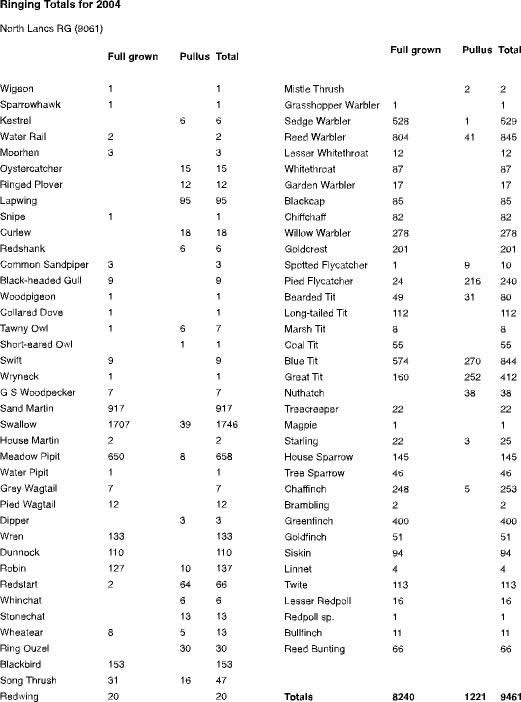

|
Newsletter of the Lancaster and District
Birdwatching Society |
 |
News From the Ringing Group
Spring 2005 |
 |
|
Another Successful Year
It has been another record year for the ringing group with 9461 birds of 75 species being ringed. Most of our ringing is done in support of BTO national projects or our own local studies. But the ringing figures do give a guide to population trends in some species especially the warblers. It was apparently quite a good year for most warblers with increases in Whitethroat, Lesser Whitethroat and Garden Warbler. Other species were around average except for Willow Warbler which showed a very marked decline. The BTO has been highlighting the apparent decline in this species and our figures lend support to this concern.
Spring Siskins
Between March 3rd and April 22nd last year Andrew Cadman ringed 95 Siskin in his Over Kellet garden. The peak of this movement was on April 9th when Andrew caught 26 siskins. This ringing shows that numbers of this species are moving through gardens at this time of year. Among the catch on April 9th were three birds already ringed, we have now received details of these birds- one had moved 214 km in 14 days from Hereford and one 175 km in 7 days from Shropshire, both showing the mobility of this species on spring migration. The final bird had been ringed almost two years to the day near Caen in Northern France, our first Siskin from France. From previous recoveries we know that some of these passage birds are heading north to breed in Northern Scotland.
Speedy Movers
The speed of movements into and out of our area in late summer is well shown by a series of controls (birds caught and released by another ringer) just received. Two Sedge Warblers ringed in Tayside in mid August were retrapped at Leighton 7 days later. Two Sand Martins from the Lune maize field roost took 9 days to reach Hertfordshire and 13 days to reach Sussex. Another Sand Martin ringed at the same time appeared to get lost and moved NE for 80km in 9 days. Two Swallows took 15 and 9 days to reach Sussex. A Sedge Warbler took 12 days to reach Sussex but all were outdone by another Sedge Warbler ringed on August 2
nd and caught 6 days later in Manche Northern France a distance of 617 kms. Our faster mover in past years was a sedge warbler which took just 3 days to reach Sussex. Of course these are maximum timings for the birds probably did not start to move straight after ringing or were caught as soon as they arrived. Although hirudines are daylight migrants and can easily be seen moving south at this time of year, but warblers migration is rarely seen as they are night migrants.
Changes of routes between years is well shown by a Meadow Pipit ringed near Spurn Head on 8th of September 03 and retrapped on Caton Moor 2 days to a year later. Another intriguing recovery was of a juvenile Sedge Warbler ringed on August 13th 03 and caught in the northern Netherlands on 28th May 04 right in the middle of the breeding season. Was it a Dutch bred bird which had strayed west in late summer or had a British bred bird decided to change its breeding area?
Twite Come up With More Surprises
Our winter ringing of twite at Heysham has revealed that they are part of the Hebrides breeding population with one sighting in the Outer Hebrides and 8 from the Inner Hebrides. Despite intensive colour ringing of the Pennine breeding population there has been no reports of these birds from the Lancashire coast - they all appear to winter along the east coast.
So we were very surprised to receive reports of two of
our birds from the east coast at Donna Nook in Lincolnshire.
One from this year's early winter ringing, suggesting that it moved across country.
What further surprises will the study of this increasing winter visitor reveal?
